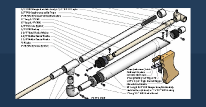Springs
#1

Posted 06 May 2009 - 07:10 AM
Proud Oklahoman NERFer.
#2

Posted 06 May 2009 - 07:31 AM
They're pretty much the same. AR-15 springs come in two different lengths though.I need to know which spring is stronger; Ar-15 or +bow? I need to know so I can start my new homemade project.
Edited by CaptainSlug, 06 May 2009 - 07:32 AM.
#3

Posted 06 May 2009 - 08:03 AM
They're pretty much the same. AR-15 springs come in two different lengths though.I need to know which spring is stronger; Ar-15 or +bow? I need to know so I can start my new homemade project.
Sorry Slug, but I have to differ on this one.
I have an AR15 spring right here alongside the [k26] spring, which is the +Bow spring.
The +Bow is thicker wire, has a 1/16" smaller ID and is in fact a MUCH stronger spring. I can take pictures of the AR15/[k25]/K27 together for comparison, but there is no question in my mind that the AR-15 buffer spring is not nearly as strong as the +Bow spring.
If you want a good spring for a homemade, try the [k25] from McMaster, which is listed in my LpL Sales Thread as the LpL Spring, it's nice and versatile and it fits perfectly inside 1" PVC.
Edited by hereticorp, 06 May 2009 - 01:45 PM.
#4

Posted 06 May 2009 - 08:26 AM
I stopped using AR-15 springs quite a while ago because they cost more.
Edited by CaptainSlug, 06 May 2009 - 08:26 AM.
#5

Posted 06 May 2009 - 10:50 AM
The +Bow spring is the 9637K26, (0.08" wire diameter, 0.844" OD, 3.09 coils/inch, 130 constant)
while the "LpL" spring is the 9637K25 (0.08" wire diameter, 0.968 OD, 2.18 cpi, 84 constant)
but even the weaker [k25] is stronger than the AR-15 spring.
The 9637K27 is a beast, with 0.08 Wire diameter, 0.72" OD, 3.55cpi, and a 225 constant.
Edited by Draconis, 06 May 2009 - 10:52 AM.
[15:51] <+Rhadamanthys> titties
[15:51] <+jakejagan> titties
[15:51] <+Lucian> boobs
[15:51] <+Gears> titties
[15:51] <@Draconis> Titties.
[15:52] <+Noodle> why is this so hard?
#6

Posted 06 May 2009 - 01:46 PM
Ahh... Yer trying to confuse folks again, Hereticorp.
The +Bow spring is the 9637K26, (0.08" wire diameter, 0.844" OD, 3.09 coils/inch, 130 constant)
while the "LpL" spring is the 9637K25 (0.08" wire diameter, 0.968 OD, 2.18 cpi, 84 constant)
but even the weaker [k25] is stronger than the AR-15 spring.
The 9637K27 is a beast, with 0.08 Wire diameter, 0.72" OD, 3.55cpi, and a 225 constant.
Fixed.

Top to Bottom: [k26] (+Bow), [k25] (LpL), AR-15 Buffer Spring
Edited by hereticorp, 06 May 2009 - 02:53 PM.
#7

Posted 06 May 2009 - 03:55 PM
Although nesting probably isn't smart for a homemade, as most homemades have a plunger draw of 6-7" allowing you full use of the spring (k19+[k26] gives you 65 lbs at full deflection of the k19). Nesting is much better for spring replacement in blasters, which have a draw of 3-4"
If you do want the beastly spring, instead of the k27, I'd rather use the k14 (1.093 ID, .105 WD x 2.45 cpi, 9.05 lbs/in from McMaster constant of 181.2). The larger OD and WD gives you better force distribution on a plunger head and total force for full deflection is higher (73 lbs vs. 63 lbs). The only slight disadvantage is 74% compression vs. 75% compression, meaning effective plunger volume is minisculely less.
---------------------------------------------------------------------------------------------
Also, while CaptainSlug hates math, the rest of us aren't as experienced in judging by wire diameter, so here's some handy formulas for comprehending the idiotic constant McMaster gives:
Constant of x inches of spring = [McMaster constant] / [Coils Per Inch * x]
Compression Ratio = 1 - (Coils Per Inch * Wire Diameter)
Max deflection of x inches of spring = x * Compression Ratio (this is the compression stroke, which must be greater than or equal to the plunger draw)^
Max force of x inches of spring = Max deflection * Constant in lbs/in
Example, using 11" of the +bow spring (full length)
Deflection rate = 1 - 3.09*.08 = 75.3% (a 10" section will compress 7.53")
Constant = 131.9/(3.09*11) = 3.88 lbs/in
Force of a full length +bow = 11*.753*3.88 = 32.1Spring constant in lbs/in = [McMaster constant] / [Coils Per Inch * Full Length]
Compression Ratio = 1 - (Coils Per Inch * Wire Diameter)
Deflection = Length * Compression Ratio (this is the compression stroke, which must be greater than or equal to the plunger draw)^
Force = Deflection * Constant in lbs/in
^Alternatively, we can use the following two formulas:
Compressed Ratio = Coils Per Inch * Wire Diameter
Solid Length = Length * Compressed Ratio (this is the length at max deflection, which much be less than or equal to free space in the plunger stroke. Free space = plunger length - plunger stroke)
Edited by Zorn's Lemma, 13 May 2009 - 01:02 AM.
Kruger and Dunning (1999)
#8

Posted 06 May 2009 - 04:23 PM
Proud Oklahoman NERFer.
#9

Posted 06 May 2009 - 05:25 PM
#10

Posted 06 May 2009 - 05:46 PM
Not to hi - jack your thread but what's the mcmaster number for the ar-15?
McMaster doesn't sell AR-15 springs, you have to get them from an arms supplier.
You can get something similar though, if you can figure out what spring is half the pull strength of the +Bow spring.
#11

Posted 06 May 2009 - 07:42 PM
Also, while CaptainSlug hates math, the rest of us aren't as experienced in judging by wire diameter, so here's some handy formulas for comprehending the idiotic constant McMaster gives:
Spring constant in lbs/in = [McMaster constant] / [Coils Per Inch * Full Length * Compression Rate]
Compression/Deflection rate = 1 - (Coils Per Inch * Wire Diameter)
Force = Length * Compression Rate * Constant in lbs/in
Total Force = Total Length * Compression Rate * Constant in lbs/in = [McMaster constant] / [Coils Per Inch]
Example, using the +bow spring:
Deflection rate = 1 - 3.09*.08 = 75.3% (a 10" section will compress 7.53")
131.9/(3.09*11*.753) = 5.15 lbs/in
Full length +bow is 11", so total force for max deflection is 11*.753*5.15 = 131.9/3.09 = 42.7 lbs
This is very incorrect.
The spring stiffness (AKA k or the "spring constant"; the force per unit length) is given by [McMaster-Carr constant] / [Coils/inch * Length] based on what McMaster-Carr has said. I have no idea where your "compression/decompression rate" comes from. This stiffness value agrees very well with theoretical values as I said in this earlier post. In fact, it agrees so well with theoretical values that it would not be unreasonable to assume that theoretical calculations determined the McMaster-Carr constant (chi^2 = 3.8e-4 with 30 degrees of freedom if you want specifics).
The force of the spring is the displacement multiplied by the stiffness (F = k * x) and again, your compression rate is not involved. Also, the displacement is not the total length. Using the total length as the displacement means that the spring is squished so small as to have no length. Geometry restricts displacement as the coils pile up and due to the spring yielding (permanent deformation like bending) some springs shouldn't be pulled that far.
Also, I see many people throwing around force numbers as if they are the primary factor in the power of a blaster. The energy stored in the spring is much more important. The energy stored in a spring is given by 0.5 * k * x ^ 2 where x is the displacement. With that being said, it'd only be a rough indication as many other factors are involved.
#12

Posted 06 May 2009 - 08:42 PM
Also, the displacement is not the total length. Using the total length as the displacement means that the spring is squished so small as to have no length. Geometry restricts displacement as the coils pile up and due to the spring yielding (permanent deformation like bending) some springs shouldn't be pulled that far.
This is exactly why the compression rate must be used. Taking the McMaster constant and dividing by CPI gives total load weight of that spring. To determine lbs/in, we divide load by the total effective length of the spring. This is the length the spring compresses, which unless you have a WD of 0 is not equal to the total length, as you are doing.
Your method works for you, because you multiply by entire lengths of spring. This is fine as long as you take the spring to full deflection.
Moreover, spring constant (what you call stiffness) is very important, because for any given blaster, compression distance is fixed.
Kruger and Dunning (1999)
#13

Posted 06 May 2009 - 09:04 PM
This is exactly why the compression rate must be used. Taking the McMaster constant and dividing by CPI gives total load weight of that spring. To determine lbs/in, we divide load by the total effective length of the spring. This is the length the spring compresses, which unless you have a WD of 0 is not equal to the total length, as you are doing.
Your method works for you, because you multiply by entire lengths of spring. This is fine as long as you take the spring to full deflection.
Moreover, spring constant (what you call stiffness) is very important, because for any given blaster, compression distance is fixed.
I see where you're coming from now. The force equation is correct then, unless you factor in yielding and other effects, which is important in some springs (unless you don't care and will replace bad springs when that time comes). Let me note that it's not accurate to call it a "compression rate" because that implies that it's a rate rather than a geometric limit.
However, the stiffness calculation is wrong. The length there is the total spring length and not the displacement.
Anyway, as I said, what I do matches theoretical stiffness values extremely well, so I'm very certain this is correct (unless you want to argue with Shigley's Mechanical Engineering Design, where I got the equation from).
Edited by Doom, 06 May 2009 - 09:04 PM.
#14

Posted 06 May 2009 - 09:30 PM
I don't know where you're getting experimental stiffness values from, but my calculations match up with CaptainSlug's data on the +bow spring.
Kruger and Dunning (1999)
#15

Posted 06 May 2009 - 10:01 PM
For the theoretical equation, follow the link in my post. You'll end up here: http://www.efunda.co...mp_designer.cfm
The equation behind that calculator is here: http://www.efunda.co...esigner_eqn.cfm
That equation is exactly the same as the the one in my book.
I get my data from McMaster-Carr. Take a look at this spreadsheet if you want some more solid numbers: http://trettel.org/nerf/springs.xls
Note that I have a chi^2 column. This is used to test how well a theory fits data. The critical chi^2 value with 99.9% certainty is 59.7. If the chi^2 value is higher than that, the theory is a bad fit. My theory has a chi^2 of 3.8*10^-4, which is extremely small and indicates the theory and data are in agreement. Yours has one of 75.5 which is far beyond the critical value and indicates a poor fit.
Edited by Doom, 07 May 2009 - 12:11 PM.
#16

Posted 06 May 2009 - 11:28 PM
Let me just make sure I understand you and run through a row of numbers with you. I'm going to use the +bow spring, since that's everyone's favorite.
I'm going to use http://www.engineers...l_materials.htm for properties reference
The +bow spring has OD of .84 and WD of .08. Length is 11" with 3.09 CPI. McM = 131.9 This gives D_mean of .76 and n_a \tilde= 34 coils.
k_theory is given by \frac{G*WD^4}{8*D_mean^3*n_a}
k_theory = (11.5*10^6 * .08^4)/(8 * .76^3 * 34) = 3.95 lbs/in
k_doom is proposed as \frac{McM}{CPI*Length}
k_zorn is proposed as \frac{k_doom}{1-CPI*WD}
k_doom = 131.9/(3.09*11) = 3.88
k_zorn = k_doom/(1-3.09*.08) = 5.15
Since we only have 1 point of comparison, we can't exactly look at the distribution statistics, but it's quite obvious that your model is far more accurate than mine.
I'm updating my original post. However, this also means McMaster is completely batshit, as they are giving you the constant of an infinite length spring (and thus solid length of the spring doesn't matter), but taken at a set length. That is, they pretend all 11" of the spring full compress when giving you the constant.
Edited by Zorn's Lemma, 06 May 2009 - 11:42 PM.
Kruger and Dunning (1999)
#17

Posted 06 May 2009 - 11:34 PM
[15:51] <+Rhadamanthys> titties
[15:51] <+jakejagan> titties
[15:51] <+Lucian> boobs
[15:51] <+Gears> titties
[15:51] <@Draconis> Titties.
[15:52] <+Noodle> why is this so hard?
#18

Posted 07 May 2009 - 12:47 AM
(Wire diam.) x (Coils/Inch) x (Spring length) = (Compressed Length)
(Spring Length) - (Compressed Length) = (Spring travel)
I ended up just measuring the load of the spring using a postal scale. From that I could get my own accurate measure of the lb./in.
A constant of 140 is definitely the upper limit in terms of what is usable in a Nerf spring plunger setup.
Edited by CaptainSlug, 07 May 2009 - 12:49 AM.
#19

Posted 07 May 2009 - 06:40 AM
Got it. Although, you made a mistake when doing k_Zorn on the spreadsheet, taking k_model rather than k_Doom, but it matters little.
Yes, I did. I've corrected it in mine but haven't updated the uploaded spreadsheet.
I'm updating my original post. However, this also means McMaster is completely batshit, as they are giving you the constant of an infinite length spring (and thus solid length of the spring doesn't matter), but taken at a set length. That is, they pretend all 11" of the spring full compress when giving you the constant.
Thanks. I'm just trying to make sure we're all on the same page here in terms of understanding what these numbers mean.
You're confused about what matters here. The stiffness is not a function of deflection, which is what you seemed to say earlier (though here what you're saying seems different). The stiffness is a function of the number of active coils, which is a function of length and end geometry. An infinite length spring would have a stiffness of zero by this rule.
If you neglect the number of active coils in the theoretical equation you'll notice that the numbers returned are nearly exactly the same as the McMaster-Carr constant... this is not a coincidence. Note that the number of active coils is approximately the coil/inch multiplied by the total length. This is precisely the procedure I take based on what McMaster-Carr says.
To determine how many inches long your spring should be, take the spring constant and divide it by the number of coils per inch. Then take this value and divide it by your desired spring rate in lbs./inch.
To get k you divide by the spring length instead of the desired spring rate (algebra says these can be switched). Note that it says "how many inches long your spring should be" too and not total deflection. Perhaps I should have bought this up earlier rather than my theoretical nonsense.
Edited by Doom, 07 May 2009 - 07:10 AM.
#20

Posted 07 May 2009 - 10:46 AM
Unfortunately, they take (lbs/in)*(coils) instead. Dividing their constant by CPI yields not the load rating of 11" of spring but of a 14.6" section of spring (with CPI of 3.09 and WD of .08). Thus, what I meant by "infinite spring" is that McMaster's constant regards the spring in the abstract, rather than as a spring of specific length with defined load-bearing and compression properties.
And here, I'd like to clarify something. If we take a given spring and cut it in half, do we double the constant? In other words, if a full length +bow spring attains maximum deflection at 32 lbs, does any arbitrary segment of the spring also attain maximum deflection at 32 lbs? If I understand your formulas correctly, this is what happens, which seems massively counterintuitive.
Edited by Zorn's Lemma, 07 May 2009 - 10:53 AM.
Kruger and Dunning (1999)
#21

Posted 07 May 2009 - 12:43 PM
Unfortunately, they take (lbs/in)*(coils) instead. Dividing their constant by CPI yields not the load rating of 11" of spring but of a 14.6" section of spring (with CPI of 3.09 and WD of .08). Thus, what I meant by "infinite spring" is that McMaster's constant regards the spring in the abstract, rather than as a spring of specific length with defined load-bearing and compression properties.
I'm not quite following your logic here. Maybe you could explain more or someone else could point it out for me.
Dividing the McMaster-Carr constant by CPI doesn't return anything specific to a certain length. And I'm not quite sure where the longer length you've mentioned comes into play here. As the theoretical formula shows and I tried to explain in my last post, the total number of active coils is what you're actually dividing by. The total number of active coils is approximately the spring length multiplied by the coils per inch.
And here, I'd like to clarify something. If we take a given spring and cut it in half, do we double the constant? In other words, if a full length +bow spring attains maximum deflection at 32 lbs, does any arbitrary segment of the spring also attain maximum deflection at 32 lbs? If I understand your formulas correctly, this is what happens, which seems massively counterintuitive.
The stiffness should double, yes. It might seem a little counterintuitive at first but it makes sense and is easily verifiable by noting that two springs in series are much easier to move than one spring.
#22

Posted 07 May 2009 - 03:47 PM
I'm not quite following your logic here. Maybe you could explain more or someone else could point it out for me.
Dividing the McMaster-Carr constant by CPI doesn't return anything specific to a certain length. And I'm not quite sure where the longer length you've mentioned comes into play here. As the theoretical formula shows and I tried to explain in my last post, the total number of active coils is what you're actually dividing by. The total number of active coils is approximately the spring length multiplied by the coils per inch
The units of the McMaster constant is Coils*Lbs/Inch. I interpreted this as (Coils/Inch)*Lbs whereas the correct interpretation is (Lbs/Inch)*Coils. Under my interpretation, McM/CPI = load rating of the spring. This is clearly not the case. On the one hand, it's rather unfortunate, but on the other, it makes much more sense since continuous-length springs are meant to be cut to size, so properties based on the static starting length of 11" doesn't really mean much.
Kruger and Dunning (1999)
#23

Posted 13 May 2009 - 12:52 AM
#24

Posted 13 May 2009 - 07:32 PM
So my question for those on here is what is most important in optimizing a spring in some different circumstances... What type of spring numbers dominate each of the following circumstances? (# coils, length of travel, coil diameter, wire diameter, spring constant, etc)
What if you want a high impulse blast (short barrel, short travel)?
What if you want a long impulse blast (long barrel, long travel)?
What number is most important for a 'faster spring'?
#25

Posted 14 May 2009 - 01:05 PM
As I said earlier, energy stored in the spring is proportional to the kinetic energy of the dart assuming relatively constant efficiencies between blasters. So, performance should be approximately the same for the same energy stored in the spring.
This equation relates energy stored in the spring to its stiffness and displacement:
Espring = 0.5 * k * x^2
where k is the spring stiffness and x is the displacement.
Acceleration of the dart is proportional to the spring stiffness/constant (because the force is proportional to the pressure, which is proportional to the spring force, which is proportional to the spring stiffness). So for higher acceleration at a certain energy you want a higher stiffness and lower displacement.
For low acceleration with a long barrel to build up to the desired kinetic energy more slowly, you want a lower stiffness and higher displacement.
Perhaps when I have more free time I'll write a primer up describing some basic equations that govern springs as applied to Nerf.
1 user(s) are reading this topic
0 members, 1 guests, 0 anonymous users

















